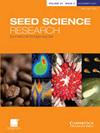Deep complex morphophysiological dormancy in seeds of Viburnum plicatum var. formosanum (Adoxaceae) from subtropical mountains
IF 1.9
3区 生物学
Q2 PLANT SCIENCES
引用次数: 1
Abstract
Abstract Viburnum is a temperate-zone genus that also occurs in mountains of South America and Malesia, and seeds of many species have morphophysiological dormancy (MPD). Information on the level of MPD in seeds of species in various clades of Viburnum potentially would increase our understanding of the evolutionary relationships between the nine levels of MPD. Our aim was to determine the level of MPD in seeds of Viburnum plicatum var. formosanum that is endemic to mountains (1800–3000 m a.s.l.) in Taiwan and a member of the Lutescentia clade. The temperature requirements for embryo growth and root and shoot emergence and response of seeds to gibberellic acid (GA) were determined. No fresh seeds germinated during 16 weeks of incubation at 15/5, 20/10, 25/15, 30/20 or 25°C. Embryo growth and root emergence occurred during moist cold stratification at 5°C or at a temperature sequence of 15/5 to 5°C. During cold stratification, embryos length increased from 0.76 ± 0.06 to 3.40 ± 0.26 mm and the embryo length:seed length ratio from 0.20 ± 0.02 to 0.68 ± 0.07. In a temperature sequence simulating field conditions, embryos grew inside seeds at 5°C, roots emerged at 15/5°C and shoots emerged at 20/10°C. The optimum temperature for embryo growth was 5°C. Neither GA3 nor GA4 was effective in promoting root emergence. We conclude that seeds of V. plicatum var. formosanum have deep complex MPD, which is a first report for Viburnum. Dormancy release during the cool season at high elevations helps to ensure that seeds germinate at the beginning of the warm season.亚热带山地扁荚豆种子深层复杂形态生理休眠
摘要Viburnum是一个温带属,也分布在南美洲和马来西亚的山区,许多物种的种子都具有形态生理休眠(MPD)。关于Viburnum不同分支物种种子中MPD水平的信息可能会增加我们对MPD九个水平之间进化关系的理解。我们的目的是测定台湾Viburnum plicatum var.formosanum种子中MPD的水平,该品种是台湾山区(1800–3000 m a.s.l.)的特有品种,也是木犀科的一员。测定了胚生长、根冠出苗的温度要求以及种子对赤霉素(GA)的反应。在15/5、20/10、25/15、30/20或25°C的培养16周内,没有新鲜种子发芽。胚胎生长和根出现在5°C或15/5至5°C的温度序列下的湿冷分层过程中。在冷分层过程中,胚胎长度从0.76±0.06增加到3.40±0.26mm,胚胎长度与种子长度之比从0.20±0.02增加到0.68±0.07。在模拟田间条件的温度序列中,胚胎在5°C的温度下在种子内生长,根在15/5°C时出现,芽在20/10°C时产生。胚胎生长的最适温度为5°C。GA3和GA4均不能有效促进根系的出苗。我们得出结论,台湾皱皱襞病毒种子具有深层复杂的MPD,这是Viburnum的首次报道。在高海拔地区的凉爽季节释放休眠有助于确保种子在温暖季节开始时发芽。
本文章由计算机程序翻译,如有差异,请以英文原文为准。
求助全文
约1分钟内获得全文
求助全文
来源期刊

Seed Science Research
生物-植物科学
CiteScore
3.60
自引率
4.80%
发文量
23
审稿时长
>12 weeks
期刊介绍:
Seed Science Research, the official journal of the International Society for Seed Science, is a leading international journal featuring high-quality original papers and review articles on the fundamental aspects of seed science, reviewed by internationally distinguished editors. The emphasis is on the physiology, biochemistry, molecular biology and ecology of seeds.
 求助内容:
求助内容: 应助结果提醒方式:
应助结果提醒方式:


